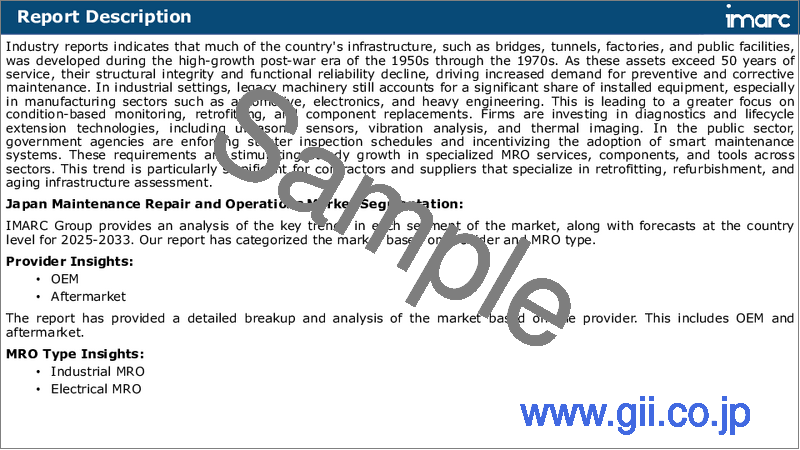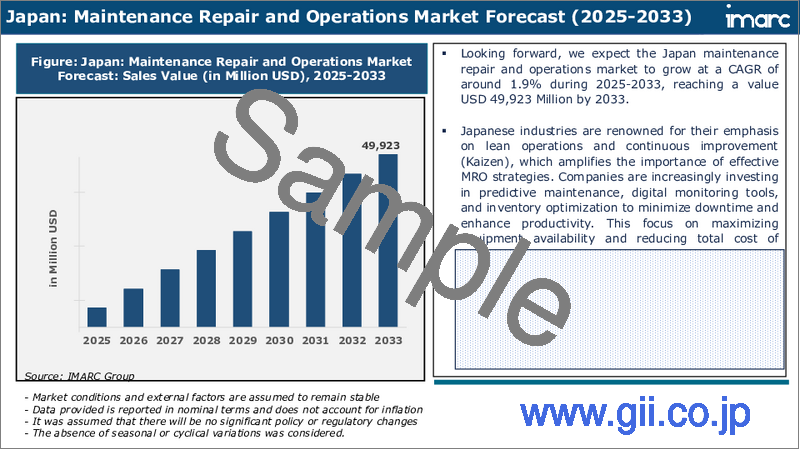|
|
市場調査レポート
商品コード
1747154
MRO(保守・修理・運用)の日本市場 - 市場規模、シェア、動向、予測:プロバイダー別、MROタイプ別、地域別、2025年~2033年Japan Maintenance Repair and Operations Market Size, Share, Trends and Forecast by Provider, MRO Type, and Region, 2025-2033 |
||||||
カスタマイズ可能
|
|||||||
| MRO(保守・修理・運用)の日本市場 - 市場規模、シェア、動向、予測:プロバイダー別、MROタイプ別、地域別、2025年~2033年 |
|
出版日: 2025年06月02日
発行: IMARC
ページ情報: 英文 119 Pages
納期: 5~7営業日
|
全表示
- 概要
- 目次
日本のMRO(保守・修理・運用)市場規模は2024年に414億米ドルに達しました。今後、IMARC Groupは、2033年には499億米ドルに達し、2025~2033年の成長率(CAGR)は1.9%になると予測しています。産業オートメーションの台頭、インフラの老朽化、厳しい安全規制、業務効率重視の高まり、製造施設の拡大、技術の進歩、主要部門における予知保全のニーズの高まりなどが、日本のMRO市場シェアを拡大する主な要因となっています。
本レポートで扱う主な質問
- 日本のMRO市場はこれまでどのように推移し、今後どのように推移するのか?
- 日本のMRO市場のプロバイダー別区分は?
- 日本のMRO市場のMROタイプ別区分は?
- 日本のMRO市場の地域別区分は?
- 日本のMRO市場のバリューチェーンにおける様々なステージとは?
- 日本のMRO市場の主な促進要因と課題は?
- 日本のMRO市場の構造と主要プレーヤーは?
- 日本のMRO市場の競合状況は?
目次
第1章 序文
第2章 調査範囲と調査手法
- 調査の目的
- ステークホルダー
- データソース
- 市場推定
- 調査手法
第3章 エグゼクティブサマリー
第4章 日本のMRO市場 - イントロダクション
- 概要
- 市場力学
- 業界動向
- 競合情報
第5章 日本のMRO市場情勢
- 過去および現在の市場動向(2019~2024年)
- 市場予測(2025~2033年)
第6章 日本のMRO市場 - プロバイダー別内訳
- OEM
- アフターマーケット
第7章 日本のMRO市場 - MROタイプ別内訳
- 工業用MRO
- 電力用MRO
- 施設用MRO
- その他
第8章 日本のMRO市場 - 競合情勢
- 概要
- 市場構造
- 市場企業のポジショニング
- 主要成功戦略
- 競合ダッシュボード
- 企業評価象限
第9章 主要企業のプロファイル
第10章 日本のMRO市場 - 業界分析
- 促進要因・抑制要因・機会
- ポーターのファイブフォース分析
- バリューチェーン分析
第11章 付録
The Japan maintenance repair and operations market size reached USD 41.4 Billion in 2024. Looking forward, IMARC Group expects the market to reach USD 49.9 Billion by 2033, exhibiting a growth rate (CAGR) of 1.9% during 2025-2033. The rising industrial automation, aging infrastructure, stringent safety regulations, increasing focus on operational efficiency, and the expansion of manufacturing facilities, technological advancements and the growing need for predictive maintenance across key sectors are some of the major factors augmenting Japan maintenance repair and operations market share.
Japan Maintenance Repair and Operations Market Trends:
Emphasis on Sustainability and Circular Maintenance Practices
Environmental sustainability is increasingly shaping MRO strategies across Japanese industries, which is facilitating Japan maintenance repair and operations market growth. There is growing pressure to reduce resource consumption, minimize emissions, and extend the usable life of industrial equipment. Maintenance departments are adopting circular economy principles, thereby emphasizing reuse, refurbishment, and recycling rather than replacement. In addition to this, Japanese firms are also incorporating energy audits and emission monitoring into regular maintenance routines, especially in energy-intensive sectors such as chemicals, metallurgy, and manufacturing. According to an industry report, Japan's industry and environment ministries have a comprehensive plan to reduce greenhouse gas emissions by 60% from 2013 levels by 2035, an increase from its previous 2030 target of a 46% reduction. This move signals a stronger regulatory push toward sustainability, reinforced by frameworks such as the Act on Rational Use of Energy and evolving sustainability disclosure standards. In response to these regulations, industries across Japan, including the MRO market, are adapting their strategies to align with stricter environmental goals. MRO suppliers are increasingly offering green-certified products, energy-efficient equipment, and environmentally conscious service solutions to support decarbonization efforts. Companies are also integrating sustainable practices into their supply chains, reducing waste, and optimizing energy use in operations.
Aging Infrastructure and Industrial Equipment
Japan faces a growing challenge due to the age of its infrastructure and industrial assets, which is positively impacting Japan maintenance repair and operations market outlook. Industry reports indicates that much of the country's infrastructure, such as bridges, tunnels, factories, and public facilities, was developed during the high-growth post-war era of the 1950s through the 1970s. As these assets exceed 50 years of service, their structural integrity and functional reliability decline, driving increased demand for preventive and corrective maintenance. In industrial settings, legacy machinery still accounts for a significant share of installed equipment, especially in manufacturing sectors such as automotive, electronics, and heavy engineering. This is leading to a greater focus on condition-based monitoring, retrofitting, and component replacements. Firms are investing in diagnostics and lifecycle extension technologies, including ultrasonic sensors, vibration analysis, and thermal imaging. In the public sector, government agencies are enforcing stricter inspection schedules and incentivizing the adoption of smart maintenance systems. These requirements are stimulating steady growth in specialized MRO services, components, and tools across sectors. This trend is particularly significant for contractors and suppliers that specialize in retrofitting, refurbishment, and aging infrastructure assessment.
Japan Maintenance Repair and Operations Market Segmentation:
Provider Insights:
- OEM
- Aftermarket
MRO Type Insights:
- Industrial MRO
- Electrical MRO
- Facility MRO
- Others
Competitive Landscape:
The market research report has also provided a comprehensive analysis of the competitive landscape. Competitive analysis such as market structure, key player positioning, top winning strategies, competitive dashboard, and company evaluation quadrant has been covered in the report. Also, detailed profiles of all major companies have been provided.
Key Questions Answered in This Report:
- How has the Japan maintenance repair and operations market performed so far and how will it perform in the coming years?
- What is the breakup of the Japan maintenance repair and operations market on the basis of provider?
- What is the breakup of the Japan maintenance repair and operations market on the basis of MRO type?
- What is the breakup of the Japan maintenance repair and operations market on the basis of region?
- What are the various stages in the value chain of the Japan maintenance repair and operations market?
- What are the key driving factors and challenges in the Japan maintenance repair and operations market?
- What is the structure of the Japan maintenance repair and operations market and who are the key players?
- What is the degree of competition in the Japan maintenance repair and operations market?
Table of Contents
1 Preface
2 Scope and Methodology
- 2.1 Objectives of the Study
- 2.2 Stakeholders
- 2.3 Data Sources
- 2.3.1 Primary Sources
- 2.3.2 Secondary Sources
- 2.4 Market Estimation
- 2.4.1 Bottom-Up Approach
- 2.4.2 Top-Down Approach
- 2.5 Forecasting Methodology
3 Executive Summary
4 Japan Maintenance Repair and Operations Market - Introduction
- 4.1 Overview
- 4.2 Market Dynamics
- 4.3 Industry Trends
- 4.4 Competitive Intelligence
5 Japan Maintenance Repair and Operations Market Landscape
- 5.1 Historical and Current Market Trends (2019-2024)
- 5.2 Market Forecast (2025-2033)
6 Japan Maintenance Repair and Operations Market - Breakup by Provider
- 6.1 OEM
- 6.1.1 Overview
- 6.1.2 Historical and Current Market Trends (2019-2024)
- 6.1.3 Market Forecast (2025-2033)
- 6.2 Aftermarket
- 6.2.1 Overview
- 6.2.2 Historical and Current Market Trends (2019-2024)
- 6.2.3 Market Forecast (2025-2033)
7 Japan Maintenance Repair and Operations Market - Breakup by MRO Type
- 7.1 Industrial MRO
- 7.1.1 Overview
- 7.1.2 Historical and Current Market Trends (2019-2024)
- 7.1.3 Market Forecast (2025-2033)
- 7.2 Electrical MRO
- 7.2.1 Overview
- 7.2.2 Historical and Current Market Trends (2019-2024)
- 7.2.3 Market Forecast (2025-2033)
- 7.3 Facility MRO
- 7.3.1 Overview
- 7.3.2 Historical and Current Market Trends (2019-2024)
- 7.3.3 Market Forecast (2025-2033)
- 7.4 Others
- 7.4.1 Historical and Current Market Trends (2019-2024)
- 7.4.2 Market Forecast (2025-2033)
8 Japan Maintenance Repair and Operations Market - Competitive Landscape
- 8.1 Overview
- 8.2 Market Structure
- 8.3 Market Player Positioning
- 8.4 Top Winning Strategies
- 8.5 Competitive Dashboard
- 8.6 Company Evaluation Quadrant
9 Profiles of Key Players
- 9.1 Company A
- 9.1.1 Business Overview
- 9.1.2 Services Offered
- 9.1.3 Business Strategies
- 9.1.4 SWOT Analysis
- 9.1.5 Major News and Events
- 9.2 Company B
- 9.2.1 Business Overview
- 9.2.2 Services Offered
- 9.2.3 Business Strategies
- 9.2.4 SWOT Analysis
- 9.2.5 Major News and Events
- 9.3 Company C
- 9.3.1 Business Overview
- 9.3.2 Services Offered
- 9.3.3 Business Strategies
- 9.3.4 SWOT Analysis
- 9.3.5 Major News and Events
- 9.4 Company D
- 9.4.1 Business Overview
- 9.4.2 Services Offered
- 9.4.3 Business Strategies
- 9.4.4 SWOT Analysis
- 9.4.5 Major News and Events
- 9.5 Company E
- 9.5.1 Business Overview
- 9.5.2 Services Offered
- 9.5.3 Business Strategies
- 9.5.4 SWOT Analysis
- 9.5.5 Major News and Events
10 Japan Maintenance Repair and Operations Market - Industry Analysis
- 10.1 Drivers, Restraints, and Opportunities
- 10.1.1 Overview
- 10.1.2 Drivers
- 10.1.3 Restraints
- 10.1.4 Opportunities
- 10.2 Porters Five Forces Analysis
- 10.2.1 Overview
- 10.2.2 Bargaining Power of Buyers
- 10.2.3 Bargaining Power of Suppliers
- 10.2.4 Degree of Competition
- 10.2.5 Threat of New Entrants
- 10.2.6 Threat of Substitutes
- 10.3 Value Chain Analysis





